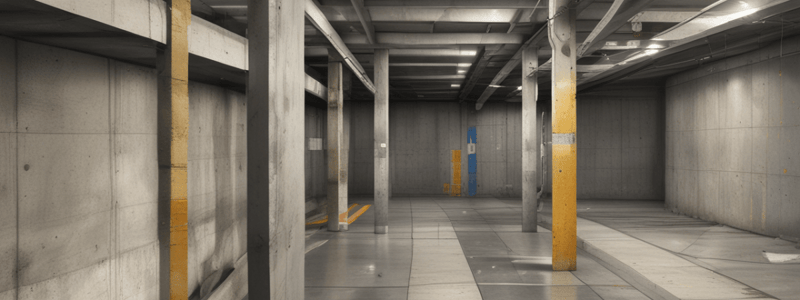Podcast
Questions and Answers
What is the standard size of the cube specimen according to BS 1881, Part 108: 1993?
What is the standard size of the cube specimen according to BS 1881, Part 108: 1993?
- 150 × 150 × 150 mm (correct)
- 250 × 250 × 250 mm
- 200 × 200 × 200 mm
- 100 × 100 × 100 mm
How many times should each layer be stroked by a hemispherical-tipped steel rod when preparing a cube specimen?
How many times should each layer be stroked by a hemispherical-tipped steel rod when preparing a cube specimen?
- 40 times
- 50 times
- 35 times (correct)
- 25 times
What is the required temperature for curing a cube specimen?
What is the required temperature for curing a cube specimen?
- 20 ± 0.5°C
- 20 ± 1.7°C
- 20 ± 2°C
- 20 ± 1°C (correct)
What is the standard size of the cylinder specimen according to ASTM C470-81?
What is the standard size of the cylinder specimen according to ASTM C470-81?
What is the length/diameter ratio of the cylinder specimen?
What is the length/diameter ratio of the cylinder specimen?
What is the primary reason for grinding or capping the upper surface of the cylinder specimen?
What is the primary reason for grinding or capping the upper surface of the cylinder specimen?
How many categories can the factors affecting the compressive strength of concrete be discussed under?
How many categories can the factors affecting the compressive strength of concrete be discussed under?
Which of the following is NOT a category of factors affecting the compressive strength of concrete?
Which of the following is NOT a category of factors affecting the compressive strength of concrete?
Which region primarily uses the cylinder specimen method?
Which region primarily uses the cylinder specimen method?
What is the primary property of concrete considered in structural design?
What is the primary property of concrete considered in structural design?
What is the relationship between compressive strength and tensile strength?
What is the relationship between compressive strength and tensile strength?
What is the empirical formula suggested by Raphael to relate tensile and compressive strengths?
What is the empirical formula suggested by Raphael to relate tensile and compressive strengths?
What is the purpose of performing a four-point bending test?
What is the purpose of performing a four-point bending test?
Why is the use of cylinder becoming more popular, particularly in research laboratories?
Why is the use of cylinder becoming more popular, particularly in research laboratories?
What is the effect of the platens of the testing machine on the strength of cube?
What is the effect of the platens of the testing machine on the strength of cube?
What is the modification by Oluokun to Raphael's formula?
What is the modification by Oluokun to Raphael's formula?
What is the relationship between the strength of cube and cylinder?
What is the relationship between the strength of cube and cylinder?
What is the expression used in the British Code of Practice BS 8007: 1987 (2006 Eurocode 2) to relate tensile and compressive strengths?
What is the expression used in the British Code of Practice BS 8007: 1987 (2006 Eurocode 2) to relate tensile and compressive strengths?
What is the primary function of sheltering the surface from wind and sunshine during construction?
What is the primary function of sheltering the surface from wind and sunshine during construction?
Why is nearly twice as much water added to the concrete mix?
Why is nearly twice as much water added to the concrete mix?
What happens to the excessive water in the concrete after curing?
What happens to the excessive water in the concrete after curing?
What is the primary factor affecting the magnitude of the ultimate shrinkage?
What is the primary factor affecting the magnitude of the ultimate shrinkage?
What percentage of the ultimate shrinkage occurs during the first year?
What percentage of the ultimate shrinkage occurs during the first year?
Why does the shrinkage increase as the ratio of the surface to volume increases?
Why does the shrinkage increase as the ratio of the surface to volume increases?
What is the range of shrinkage strain values for plain concrete members?
What is the range of shrinkage strain values for plain concrete members?
What is the effect of reinforcement on shrinkage in concrete members?
What is the effect of reinforcement on shrinkage in concrete members?
What is the range of shrinkage strain values for reinforced concrete members?
What is the range of shrinkage strain values for reinforced concrete members?
What is the primary goal of measuring the strength of concrete test specimens?
What is the primary goal of measuring the strength of concrete test specimens?
Why are cores cut from in situ concrete often of different proportions?
Why are cores cut from in situ concrete often of different proportions?
What is the purpose of trimming cores to the h/d ratio of 2 before testing?
What is the purpose of trimming cores to the h/d ratio of 2 before testing?
What is the consideration of ACI 318-08 for concrete in the part represented by a core test?
What is the consideration of ACI 318-08 for concrete in the part represented by a core test?
What is the purpose of using cores in concrete testing?
What is the purpose of using cores in concrete testing?
What is the value of D for cores drilled horizontally according to the British standard?
What is the value of D for cores drilled horizontally according to the British standard?
Why are standard correction factors for strength of cylinders with different ratios of height to diameter used?
Why are standard correction factors for strength of cylinders with different ratios of height to diameter used?
What is the main reason for testing cores for strength?
What is the main reason for testing cores for strength?
What is the primary cause of concrete deterioration?
What is the primary cause of concrete deterioration?
What is the common result of major durability problems in concrete structures?
What is the common result of major durability problems in concrete structures?
What is the primary factor affecting the durability of concrete?
What is the primary factor affecting the durability of concrete?
What is permeability defined as?
What is permeability defined as?
What affects the permeability of concrete?
What affects the permeability of concrete?
What is the difference between permeability and diffusivity?
What is the difference between permeability and diffusivity?
What is diffusivity defined as?
What is diffusivity defined as?
What is the result of the corrosion of the reinforcing steel?
What is the result of the corrosion of the reinforcing steel?
What are the five major durability problems of concrete structures?
What are the five major durability problems of concrete structures?
Flashcards are hidden until you start studying
Study Notes
Specimen Methods
- The cube specimen method is used in Europe and China, while the cylinder specimen method is used in North America.
- The standard size of the cube specimen is 150 × 150 × 150 mm, prepared by pouring concrete into a cubic mold in three equal layers, with each layer being stroked 35 times by a hemispherical-tipped steel rod.
- The standard cylinder size for compression testing is 150 × 300 mm, prepared by pouring concrete into the cylindrical mold in three equal layers, with each layer being stroked 25 times by a hemispherical-tipped steel rod.
Factors Affecting Compressive Strength
- Characteristics and proportions of materials
- Curing conditions
- Testing parameters
Relation between Compressive and Tensile Strengths
- As compressive strength (fc) increases, tensile strength (ft) also increases but at a decreasing rate.
- Empirical formulas relate tensile and compressive strengths, such as ft = 0.3(fc)2/3 and ft = 0.2(fc)0.7.
Comparison between Cube and Cylinder Strength
- The strength of the cube is different from the strength of the cylinder due to the restraining effect of the platens of the testing machine.
- Normally, the strength of the cylinder is taken as 0.8-0.85 times the strength of the cube.
Effect of Height/Diameter Ratio on Strength of Cylinders
- Standard cylinders have a height/diameter ratio of 2, but sometimes specimens of other proportions are encountered.
- Correction factors are used to estimate the strength of cylinders with different ratios of height to diameter.
Test Cores
- Cores can be used to detect segregation or honeycombing, check the bond at construction joints, or verify the thickness of pavement.
- The average strength of 3 cores should be at least 85% of the specified strength, and no single core should have a strength lower than 75% of the specified value.
Drying Shrinkage and Durability
- Drying shrinkage occurs as the concrete volume shrinks due to moisture loss, and the shrinkage strain is time-dependent.
- The magnitude of the ultimate shrinkage is primarily a function of the initial water content of the concrete and the relative humidity of the surrounding environment.
- Factors influencing durability include environmental factors, mechanical loading, and the coupling effect of both.
Permeability and Diffusivity
- Permeability is the property that governs the rate of flow of a fluid into a porous material under pressure.
- Diffusivity is the rate of migration of ions or moisture in concrete under the action of a higher concentration side to lower concentration side.
- Both permeability and diffusivity affect the durability of concrete.
Studying That Suits You
Use AI to generate personalized quizzes and flashcards to suit your learning preferences.




